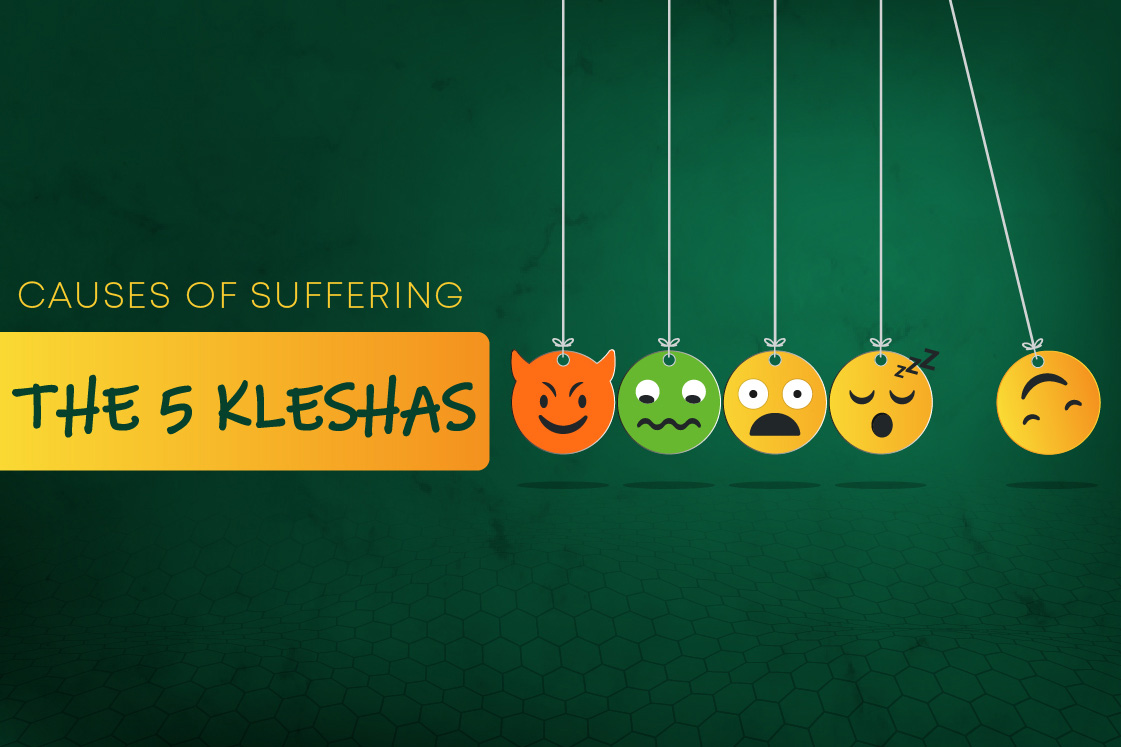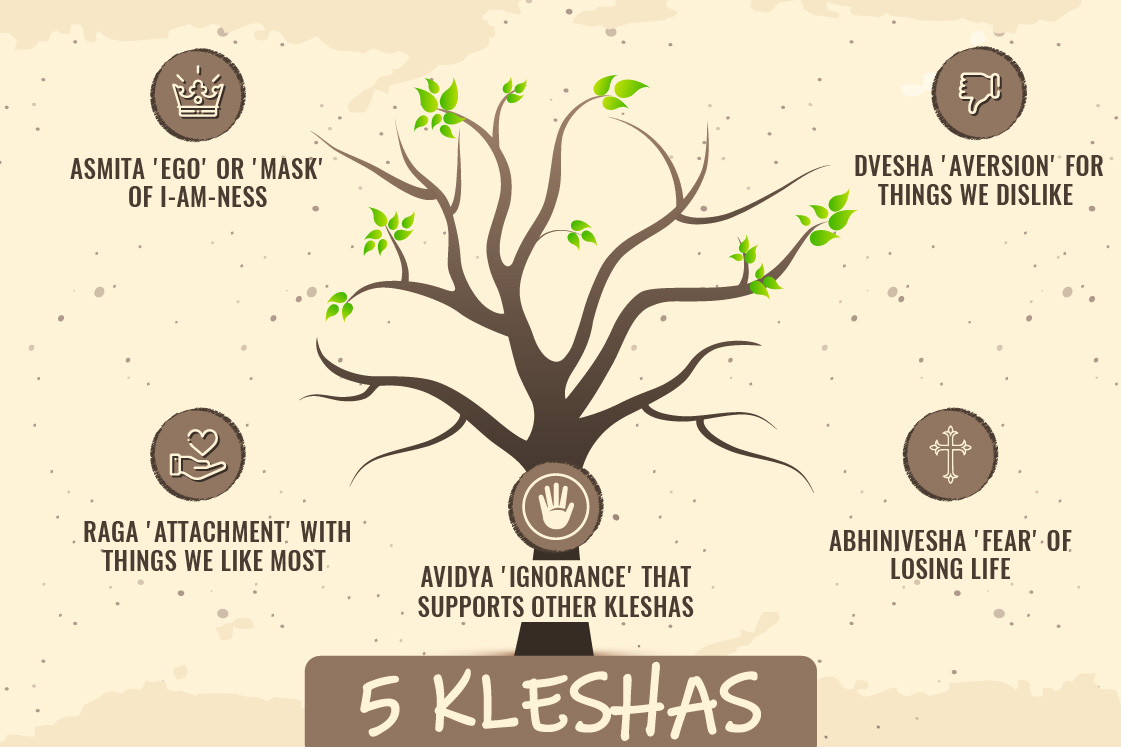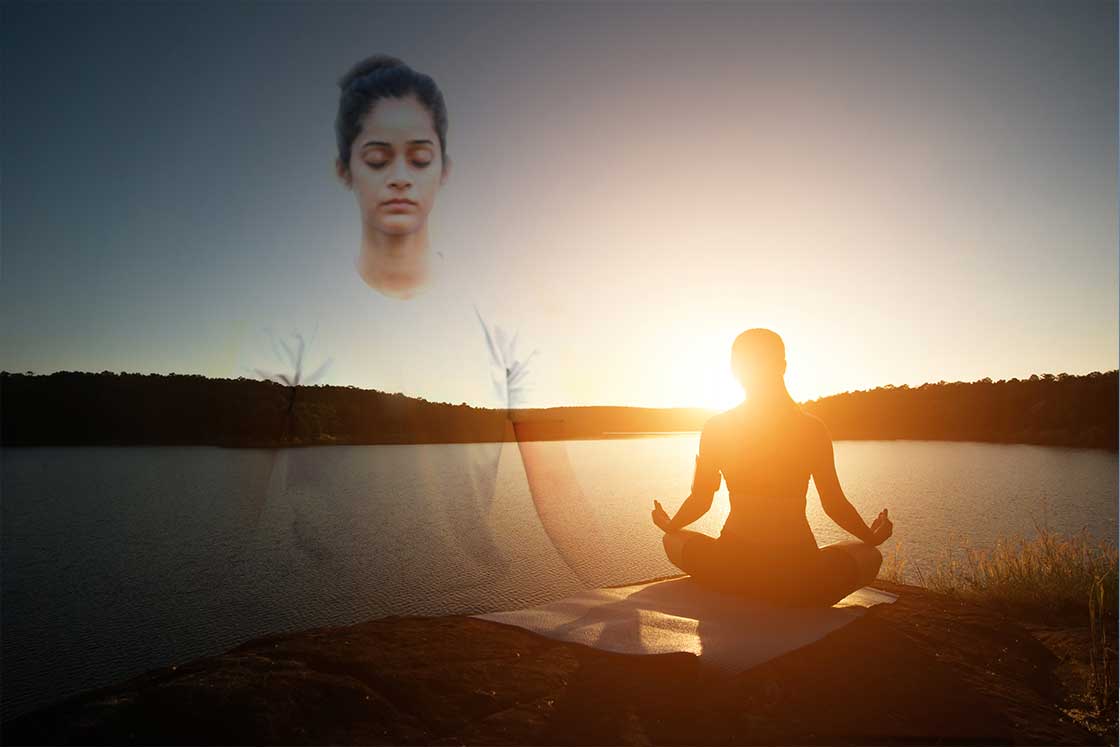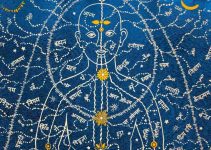
Do negative emotions pop up in your mind and make you feel sad, angry, egoistic, guilty & discouraged from time to time?
If yes, this article can be an antidote for you.
And if no, this article can work as a vaccine for you.
The negatives thoughts here I am talking about, are called kleshas in yogic language.
What is Klesha?
Maharshi Patanjali, Author of Patanjali Yoga Sutra (PYS) & the greatest psychologist of ancient India, divided all the human thoughts into two categories i.e. Klishta and Aklishta.
Vrttayah-Pancatayyah-Klista-Aklistah – PYS (1.5)
According to this sutra, all the human thoughts accompany some emotions with them.
Some thoughts carry happiness, peace, clarity and neutral feelings with them, these thoughts or vrittis are called Aklishta vritti i.e. thoughts not accompanied by kleshas and are not painful.
See also:
How vrittis generates thoughts?
On the other hand, some thoughts carry confusion, pain, fear, stress and anxiety. These thought patterns or vrittis are called Klishta vritti i.e. thoughts accompanied by klesha and hence, are painful.
So, klesha which also means “poison” is nothing but thoughts that generate pain in our experience.
Note: Kleshas are not mental sufferings due to work-related stress or personal problems, they are inborn mental affliction and present in your mind since birth, but the solutions to the kleshas can eliminate all kinds of stresses.
What Does the Klesha Do?
Klishta vritti or Kleshas is a Sanskrit word which means troublesome. They stop you from seeing the things as they really are and hinders your perception.
So if the nature of your kleshas is red, you will see everything in red as if it acted like a glass and you look at the world through it. They are inborn mental afflictions that stop you from looking at the things the way they are.
Man is born with kleshas, they are mental in nature & man is afflicted by them.
In other words, Klesha is like a corrupted malware in your computer which often pops up on your computer screen from nowhere and distracts you from doing the things you should be doing.
Kleshas In Buddhism
Everyone who takes birth, Buddha said, to realize the self, should go through 4 noble truths [efn_note] Four Noble Truths [https://en.wikipedia.org/wiki/Four_Noble_Truths] [/efn_note] in this life.
- There is suffering (dukkham), which comes with the existence of life
- Cause of this suffering
- Eliminating the causes of suffering
- Noble eightfold path to end the suffering (achieving liberation).
In the Buddhist tradition, sufferings are categorised into 108 kleshas. These are represented as beads in Buddhist prayer.
108 kleshas made up in this way;
- 6 sense (vision, smell, hearing, touch, taste & consciousness)
- 3 reactions through each sense (positive, negative, neutral)
- Attachment or detachment with each reaction (2 passions)
- Passion of past, present or future (3)
In this way, 108 kleshas according to Buddhism is 6*3*2*3 = 108 klesha
108 kleshas are stems out of 5 kleshas in yoga.
5 Kleshas: Causes of Human Sufferings

Avidya-Asmita-Raga-Dvesa-Abhinivesa-Klesah ~ PYS (2.3)
With this sutra, Maharshi Patanjali says there are five major causes of human sufferings or 5 kleshas. The 5 kleshas are
- Avidya
- Asmita
- Raga
- Dvesha
- Abhinivesh.
Let’s understand each klesha one by one:
1. Avidya – Lack of Knowledge/Reality/Understanding
Avidya is that every single thought, karma or experience which obstruct you from knowing your real identity.
Your real identity is not the last name you got from your parents or the work you do & nor it’s measured by the wealth you have. These all identities we got after birth takes place. When we limited our perception up to these identities only, it’s called Avidya.
Your real identity is that unbound awareness which you only can feel in the state of deep meditation.
Avidya, the first klesha, is the ignorance of not knowing the reality of existence because of external faculties involvement with the materialistic world we live in.
avidyā kṣetram-uttareṣām prasupta-tanu-vicchinn-odārāṇām ~ (PYS 2.4)
Patanjali describes avidya with this sutra. avidya is a state when;
- The impermanent is perceived to be permanent,
- Impure is perceived to be pure,
- A thing that makes you suffer is perceived to be a pleasure
- The unreal self is perceived to be the self.
Forgetting or being unaware of the fact that we are permanent spiritual beings who are experiencing impermanent human life is the Avidya, the greatest cause of human sufferings.
[alert-success] Analogically, avidya is explained as the trunk of a tree, which is the root cause of all the human sufferings. Branches and sub-branches of this tree are other 4 Kleshas, but the base of all afflictions (kleshas) is avidya (trunk), on which other kleshas are supported. [/alert-success]The rest of the four kleshas can be clearly noticed in Avidya in different levels.
2. Asmita – Identification of Ego as Supreme
When Avidya spread in body and mind, created self (Name, Fame, Money or any materialistic identity) start dominating over true self (Soul). Our true identity of the self begins fabricated with the sense of ‘I-am-ness’ & we start identifying things with the ‘created self’. For example;
- I am rich or poor [Soul (true self) is neither poor nor rich]
- I am a good or bad person [It’s only your perception according to present conditions]
- I have done this/that or I will do this/that [You are not doer, rather just a medium]
These are some examples of Asmita.
Asmita, the second klesha, which makes us suffer by covering the true nature of the self with dozens of fake identities. Sanskrit term Asmi means I-am, hence, Asmita is the feeling which creates ‘I-am-ness’ in a person.
It’s our ego that let not us knowing the reality of mind, body & soul. Thus, the ego becomes a cause that separates living beings and hinders people from perceiving the world the way it is.
The entire universe emerges from one point only but because of ego or ahamkara, human beings separate themselves on the name of Individuality.
Yes, people who walk around you are different but they all came from the same source, it’s just our different experiences that make us different. But on a deeper level, we all are part of one consciousness.
When we were in our mother’s womb, we were conscious as a subtle cell which was developing. With time, other complex cells started accumulating around it and formed a body-mind system.
Realizing that we are just consciousness will make us free from this bondage of ego or ahamkara and we become brahman itself i.e. present in every being.
3. Raga – Attachments With Objects/Relationships/Cravings
Once Asmita (Ego – ‘I-am-ness’) start developing in us then we lean towards identities which comes with pleasurable experiences. For example;
- Your relation with family, friends, & relatives
- Your favourite chocolate, brand, or sensation of a drug
Above mentioned are some examples of Raga (attachment). It’s the 3rd klesha which makes us suffer by attaching our awareness to the materialistic identities (illusions).
Raga attracts us because humans think that their happiness is hidden in doing something or going somewhere or eating something. Humans are not bound to experience happiness in doing certain things. They are itself the manifestation of ultimate peace and can live joyfully every second of their life.
Peace and harmony is natural to man.
We often attached with things which give us pleasure in our experience, but at that same moment, our inner self knows whatever we might have, can be lost. Ultimately, when that pleasurable experience is over, suffering begins in search of getting the same pleasure again. In this way, this cycle of pleasure and pain keep running until we get out of the attachments.
So, how one can come over their attachments?
Getting over your attachment doesn’t mean detached from the world or your needs. Self-inquiry (Svadhyaya), a part of Niyama mentioned in 8 limbs of yoga, is the easiest way to know whether Raga present in your life or not.
When you started getting involved in something, ask yourself, Do I actually need it, or is it just my cravings?
Attachments can also impact mentally including paralyzing personality disorders [efn_note] attachment perspective on psychopathology [https://www.ncbi.nlm.nih.gov/pmc/articles/PMC3266769/][/efn_note].
B.K.S Iyengar stated in his book ‘Light on Yoga sutra’, the place of attachments in humans is hypothalamus (a master gland in the brain). When we get disturbed because of an attachment, hormone secretion in the whole body affected.
In this way, raga is one of the causes of human suffering.
4. Dvesha – Disliking Things You Don’t Want
To set up what you like against what you dislike, this is the disease of the mind.
~
With this quote,
Dvesha, the 4th klesha, is basically the next stage of attachment (Raga) or one can say, opposite of Raga.
- Where Raga is our attachment with something we like most, dvesha is the aversion for things which we don’t like.
- Attachment takes place based on the previously pleasant experiences while Dvesha is aversion for those unpleasant experience which doesn’t happen according to our desire.
- Dvesha is the creator of dualistic nature in a person. By influencing the situations based on ‘Good’ or ‘Bad’, we forget the real essence behind the Initiation of Karma.
For example; You met a new person & after some meetings; you become good friends. It’s the Raga i.e. attachment with pleasurable experience (beginning of suffering).
With time, you come to know about some bad habits of your friend, which causes your serious dispute with him. Now, you don’t want him as your friend.
Remember, there is neither bad nor good, it’s just our experience. Because you assumed about your friend to be like you or to have similar habits like you, it’s actually your dvesha, which comes out as aversion at this moment.
[alert-success]Indeed, expecting things according to your desire stems a repulsive behavior in you at every aspect of life.[/alert-success]Getting over Dvesha
As a human being, when things not happen based on our comfort zone, it results out as aversion (Dvesha). We run away from those things we don’t want to happen because we think that it will make us suffer. But the reality is that nothing can make a self-realized man suffer.
A self-realized man enjoys the things logically and understands everything with the full awareness that comes in his way, irrespective of likes and dislikes (Raga & Dvesha).
Practising mindfulness, doing things that are needed for the stability of mind, and wellness of fellow beings are some easiest ways to remove the Rage & Dvesha.
5. Abhinivesha – Fear of Death
Once J. Krishnamurti said in his QNA meeting, “Life is an accumulation of past experiences & thoughts while death merely is a gap of nothingness in between your thoughts.”
When it comes realizing the logic behind this statement, it’s not easy to apply in our life because of Abhinivesha – fear of death.
Abhinivesha is the 5th cause of klesha, which is our tendency to be clinging with life & its pleasure, and hence, ultimately it causes suffering when the thought of losing life comes in our mind.
In life, fear held us in many forms of thoughts, and hence with time, our mind becomes more habitual to develop negative thoughts. Fear is when
- We don’t want to lose what we already have
- Thought of not getting what we desperately looking for
- What others will think if….this & that
- Ignorance about an unknown identity
These all are some common fear we go through in our lives. It causes stress, fear, anxiety, doubts in mind & hence, afflicts us.
Getting Over the Abhinivesha
When you know the concept of Purusha and Prakriti, it becomes easier to get out of fear of death. It’s just Prakriti which make you realize everything including death. Through different paths of yoga, you can realize the Purusha, which is the source of consciousness in us.
How To Remove Kleshas?

For a yoga practitioner or a sadhaka, it is very important to be aware of troublesome thoughts or Kleshas, as identifying these thoughts is one of the first steps towards removing it.
Being aware of the klesha can be challenging but don’t worry, yoga is a science of becoming aware of each aspect of body and mind. Once you become aware of the problems, the process of finding solutions starts automatically.
The solution to all the human sufferings i.e. 5 Kleshas is “Kriya Yoga”.
What is Kriya Yoga?
tapaḥ svādhyāy eśvarapraṇidhānā ni kriyāyogaḥ.
Patanjali describes the practice of Kriya Yoga as;
- tapah – austerities,
- swadhyay – Self-inquiry
- Ishwara Pranidhana – surrender to God
It makes the kleshas weak or enfeebled in us from a dominant state. He then describes dhyana or meditation for finally getting rid of the kleshas.
Let’s dive deeper into the aspects of Kriya Yoga:
1. Tapa
Tapa means self-effort to do things that are needed to do, to become aware of mind and body. It includes doing the actions of cleanliness (saucha) and kindness for purification of body and mind as described in Yamas and Niyams of Yoga Sutra.
Tapah, in the fire of self-effort, burns the darkness and ignorance (avidya) of mind which stem cause of negative thought patterns.
2. Swadhyaya
Swadhyaya means self- inquiry.
Inquiring your thoughts and action make you realize you are just a medium (doer), the source of consciousness somewhere lies in deep down within us. It diminishes the ego (asmita)
Patanjali observed his own thoughts patterns and became a realized master. So, if you are serious to become a realized being look inward rather than looking outside.
Your vision will become clear only when you can look into your own heart. Who looks outside, dreams; who looks inside, awakens.
3. Ishwar Pranidhana
Patanjali defines Ishwara as a ‘purusa vishesha’, a special kind of Purusha (pure consciousness) – one who was never embodied, is not embodied, and who will never be embodied.
In Ishwara, the seed of omniscience is unsurpassed. The designator of this Ishwara is Pranava or AUM.
Patanjali says that the Japa of OM (AUM) should be performed with full involvement of the being and with full recognition of its significance. Such a Japa will result in the elimination of all obstacles in the path of Yoga and lead towards consciousness turning upon itself, i.e., leading to pure awareness.
concluding Thought
Patanjali gave the real source of all sufferings for a human being in chapter 2, sutra 4 of yoga sutra.
It’s the darkness of ignorance (avidya) which has covered our heart with
- Wrong identification of true self over created self (Asmita)
- Attachment to the pleasurable experiences (Raga)
- Aversions for things we don’t want to be (Dvesha)
- And lastly with fear of death (Abhinivesha)
when the layer of ignorance is removed from the surface, all suffering automatically disappears and then you realize, suffering is just an illusion.





Very well explained. thank you for all your efforts to simplify this knowledge
Is there any practical aspect in yoga to remove the negative thoughts of mind other than practices of kriya yoga?
I like the theory of tapa in elimination of klesha, but how tapa remove klesha: i want to know.
Whole Kriya yoga in itself is the branch based on the practical aspect of yoga..most common example of it is the practice of Asana. Its practice is very helpful in eliminating negative thoughts of the mind.
Tapa, on the other hand, is also a part of asana mechanism. When we devote ourself into physical or mental practices (called tapa or austerity), a state of oneness stems in our mind. This oneness freed us from the bondage of thoughts.